Biography of Hugh Calverley 1324-1394
Paternal Family Tree: Calverley
Around 1324 Hugh Calverley was born to David Calverly of Lea.
On 26 Mar 1351 the Combat of the Thirty was an arranged fight between selected combatants from both sides of the conflict, fought at at Guillac, a site midway between the Breton castles of Josselin and Ploërmel among 30 champions, knights, and squires on each side.
Robert Knollys (age 26) took part.
Hugh Calverley (age 27) fought, was captured and ransomed.
On 29 Sep 1364 Battle of Auray decided the Breton Succession in favour of John Montfort V Duke Brittany (age 25). The Breton and English army was commanded by John Chandos (age 44) and included William Latimer 4th Baron Latimer of Corby (age 34), Miles Stapleton (age 44) and Hugh Calverley (age 40). Charles "Saint" Chatillon Duke Brittany (age 45) was killed. Bertrand Geusclin (age 44) surrendered. 

On 23 Apr 1394 Hugh Calverley (age 70) died. He was probably buried in St Boniface's Church, Bunbury [Map]. Monument Early Plate Bascinet Period. Finely carved Calf's Head on the breastplate representing Hugh Calveley's canting arms. Calf's Head Crest. Hip Belt. Basinet with unusual decorated Orle.
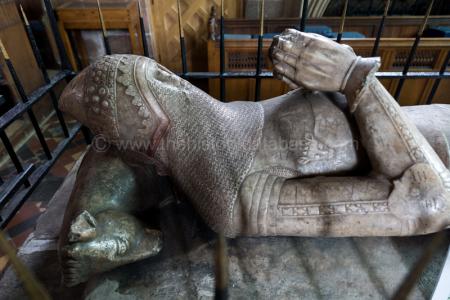
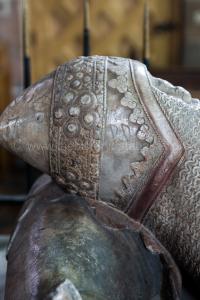
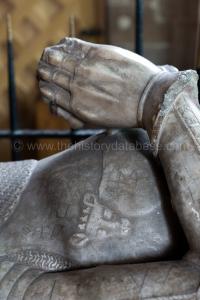
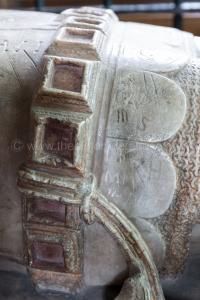
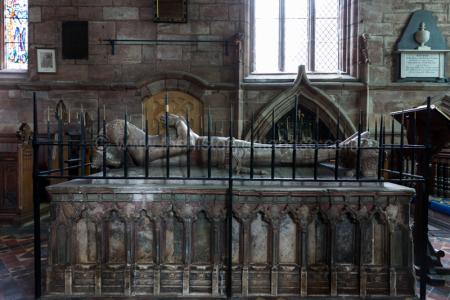
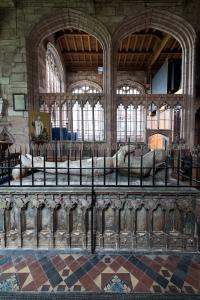
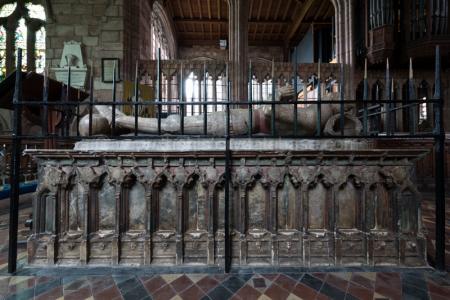
Effigy of Sir Hugh Calveley. The above are some few passages of the military career of this renowned English knight. He founded in 1386, the tenth year of the reign of Richard II a college at Rome, and at Bunbury [Map] in Cheshire. A story is extant, upon no certain foundation, that he married a Queen of Arragon. He might indeed while in Spain with the Black Prince have formed an alliance with some noble lady of the Spanish court. He reposes in an altar-tomb in Bunbury church, Cheshire [Map], which bears his eRigy as represented, and is surrounded by Gothic niches, intermixed with escutcheons.
Details. Plate 1. The effigy as originally painted. On the surcoat—the coat of Calveley, Argent, a fess Gules, between three calves Sable. Crest, a calf's head Sable. On the basinet is a rich circlet or wreath. The feet rest on a golden lion. Plate H. Profile. 1. Portion of the wreath on the basinet enlarged; also ornament of the rim of the basinet, with lace of the camail. 2. Girdle, chain suspending the sword, scabbard of the sword. 3. Mails of the hauberk and camail. 4. Part of the greave, solerette, spur, and ornamented strap.
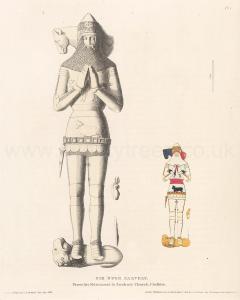
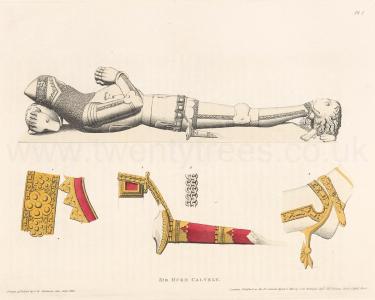
Effigy of Sir Hugh Calveley. SIR HUGH CALVELEY, or Calverley, of Lea, in Cheshire, was a most eminent soldier in the reign of Edward the Third, and his successor Richard the Second. In 1350 we find him one of the combatants in the celebrated pitched trial of arms, or combât-à-l'outrance fought between thirty men-at-arms on the English side, and thirty on that of the Bretons, called, in allusion to the number of the champions on either party, the Battle of Trente. Sir Richard Brembre commanded the English hand, and Marshal Beaumanoir the French. Among the companions of the valiant Calveley (twenty of whom were English, the rest foreigners) were, Sir Robert Knolles, also a most distinguished knight, Croquart the Freebooter, the gigantic Hulbitee, and Thomelin de Billefort, so called from his wielding an enormous weapon of the axe kind. Sir Richard Brembre was slain fighting hand-in-hand with the famous Bertram du Guesclin; Calveley, Knolles, and Croquart, the poor remains of the English party, were taken prisoners to the Castle of Josselina.